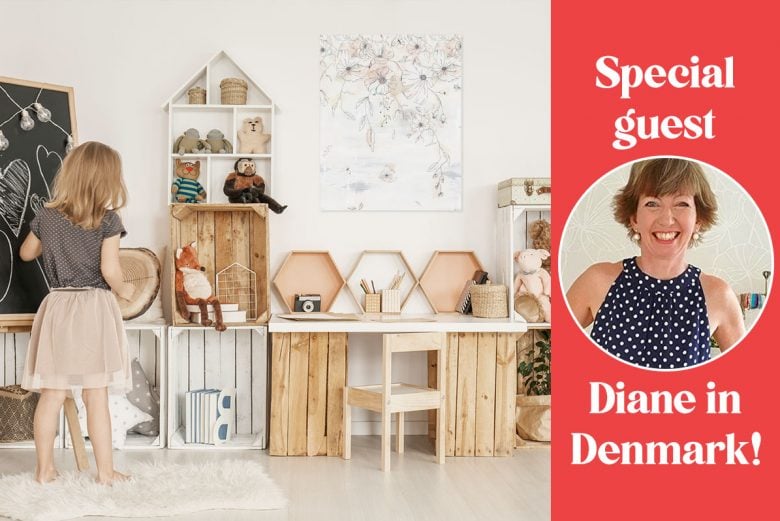
How to help them let go of clutter AND stress
How do you help your Sensitive Type 2 Child to manage their tendency to make piles and to hold onto sentimental things?
In this episode, Carol and Anne are joined by YouTuber Diane in Denmark, who teaches people how to have a happy, organized life. Her tips for Type 2 children will help your sensitive child stay tidy in a calming way.
This episode’s Parenting Practice
As you would expect, the parenting practice this week is to implement one of Diane’s tips. Type 2 children can shut down when things feel too intense, so these comforting approaches will actually save you time. in the long run. Start with one tip and then add another one.
Transcript of podcast episode
Carol: Welcome to The Child Whisperer Podcast. I’m your host Carol Tuttle, author of the best-selling parenting book, The Child Whisperer. I’m with my co-host, Anne Tuttle Brown.
We’re really enjoying the series we’re doing about life and space organization tips for each of the 4 Types of children. And today, I’m just really looking forward to supporting the Type 2 child. This is our more Sensitive Child. The Type 2 child has a soft, connected movement that has an emotional connection to their space and belongings.
And if you’ve been listening to this series, you know we’ve invited our life and space organization expert and life coach Diane in Denmark, who is famous on YouTube, followed by many. She is a Type 1 and she does have a Type 2 in her family, not her child, but her spouse. So she has experience with this. I have two Type 2 children, and I’m grateful that one of them is here with me today.
Anne: Hello.
Carol: My co-host Anne Tuttle Brown. And I have a lot of experience with what Type 2s are known for, which was a real sort of…it was funny. It was interesting for me to realize some of these sort of quirky tendencies that no other profiling system has ever pointed out. And one of those tendencies that I became aware of in the early stages of developing Energy Profiling was hmm, Type 2s are the pile makers. They acquire piles.
Anne: That is a really like a very unique trait that is true for, you know, that like you identified who has that trait through energy profiling.
Carol: Yeah, it is Type 2s. The other trait that I thought was fascinating, and this is very specific to Type 2 males, they like to keep the boxes to things.
Anne: Cords and cables, right?
Carol: Yes. I can always count on my husband having a cord or cable or a charger or something. I’ve seen…and people are sort of…they find that fascinating. How did she figure that out? I just watched. I observed.
Anne: You’ve lived with enough of them.
Carol: Yes. I’m going let Anne actually lead out on this. We’ve identified three challenges that we’ve asked Diane to come up with some tips to help… They’re challenges not because it’s any ill will of a child because children… I think parents too often think their child is being difficult. They’re not agreeable. They’re not cooperative. Well, your approach to them is not working because the tendencies and what they need, isn’t supportive when it comes to managing their space, their life.
They’re not being supported with the right…taught the right skill sets that align with them. So they’re effortless. So understanding your child’s true nature, then teaching skillsets that complement that, you get rid of the challenge. So Anne, I’m going to turn this over to you.
Anne: Oftentimes the challenge can just be a mismanagement of the gift or a misunderstanding of the gift. Because within the challenge you will see, okay, that is the true gift of that Type. So with Type 2, one of the challenges is becoming emotionally connected to what they own and having a hard time letting it go, which leads to clutter, which leads to piles, which leads to mess. And so, where’s the gift? The emotional connection.
Carol: Explain, for our benefit as well, because you personally know this emotional connection. Is it about the memory? What does it feel like for you?
Anne: Yeah, I think in like some items have just…they’ve been with you for so long, like they’ve been through it with me, like they’re part of the experience. And I think there are things that I prize and I treasure and I am very attached emotionally to them.
I do like to declutter, I like to move on and get rid of things so I’ve developed that inside of me, maybe because I was raised by you. So I do have a preference for that as well but the things…you know, I had a baby blanket that I slept with until I was 20.
Carol: You still have that baby blanket.
Anne: I still do. I don’t sleep with it anymore, but of course, I will treasure it and always have it as a keepsake now. My American Girl doll I have, and I treasure and I have all of her things, and I’m very fond of it. Fond of something…I adore it.
Carol: Just before we get to Diane’s tips, you’ve allowed…knowing you have this emotional connection, you’ve been discerning in saying, that I am going to keep because that means a lot to me.
Anne: Yeah. And I’ve been through a lot of my boxes over the years and gotten rid of more stuff. And some stuff, unfortunately, I was sad that I did let go of it. Now, thinking back, I had a really big Teddy bear collection, and I whittled it down to like six. And I’m like, I had over 30, like from all over the world that I’d collected some I had made and I was like, I wish I would’ve kept those. So that’s a little bit sad. But most of it, I’m glad I moved on. So Diane, what are your tips for the Type 2 Sensitive Child?
Diane: Okay, well, we’re going to start off with storage. So the storage in the child’s room, Type 2s, they like to see their piles of things. So probably more open storage. And the other Types we’re talking about, you know, maybe bins and boxes. The Type 2 perhaps have even a shelf around the bed to have their favorite things, things where they really have a connection so that they feel close to it.
And also, give them a couple of boxes where they can really, like you said, you have just kind of random objects that you’ve had since you were a child and a couple of boxes where they can just keep those items. They don’t fit into any category. It’s not a sense of tie, but just items that they want to hold on to. And, you know, kind of memories box. Something that, you know, a lot of children, maybe they’re having a tough time, they can pull out their kind of memory box and open up and just have a look at all their little knick-knacks.
So there’s no kind of pressure for them to have them in a certain, you know, box with plushes or Lego or books, but just these kind of random items that you collect. The only thing I would say is, you know, once that box gets full maybe you can help them to declutter it and say, okay, do you really need to hold onto these, I don’t know, toys, you know, from McDonald’s meals or whatever it is? But just give them that idea where they know they have a space to keep it, that mum’s not going to throw them out. It’s okay to have that connection with things.
Anne: Letting go of that pressure of I have to safeguard this and defend it before Mom is gonna take it away. You really want to win over your Type 2, sit down and let them tell you about all those keepsakes. You can set a timer and say, I’d love to sit down with you for five minutes, show me some of your favorite things in here. Like, oh, this, and why does that mean so much to you?
Diane: But that’s what they will learn that if they put the things in that box, that nobody else is going to take them away. And then they can see, okay, those things are special, maybe, you know, piles and piles of books, those are not so special, and then you can declutter there.
Anne: I like that. And it’s space management. So if you have this space enough for a box, then you don’t have to worry so much about the categories. And, you know, going back to my teddy bear collection that I had, I just had them all on a shelf. And I loved to look at them and I named them all. I would rearrange them sometimes. And I think, as I got older, I didn’t really have a space for them and I felt like…
Carol: But you knew you were a Type 2 by then, by the time you started to let go of them.
Anne: It’s when I really got into the KonMari declutter, and I just…I think I went too far with that maybe because I was like, they have no practical use for them. I don’t really want my kids playing with them. What do I do with them? Do I really want these? And I think like going…like maybe it doesn’t fit into any category. It didn’t, but I like to look at it. It brought up memories.
Carol: Yeah. So do you ask yourself Anne, the question, what’s my emotional connection to this?
Anne: That’s a really good question to ask.
Carol: I think since a child has this set up and it is just why they keep things, to teach them you have emotional connection to things, now let’s on a scale we need to kind of determine, is this low on the emotional connection versus high so that they work with what they already…they’re going to work with what is.
Diane: Yeah. Let them know that that’s okay, but they can…you know, they’re not going to leave home, start their own home and have their whole home filled with things because they feel emotional. That’s just not going to work.
Anne, you mentioned KonMari. KonMari does not say get rid of things just because. If you’ve got something you want to hold on to, even if it doesn’t have a usage, you get to hold onto it. And that’s a misconception there. But I think if you can give your child a couple of boxes, as I said, where, you know…and they can be very fancy, decorative, however you want, Boys it could be some kind of treasure chest, girls, it might…
Carol: That’s the word that comes to mind is treasure. I treasure this. So the treasure chest idea. But then to teach a Type 2 child not everything gets to be treasured, you’ve got to really refine what gets qualified for that.
Diane: You’re also putting a limit on it that, you know, you can’t have 15 treasure chests.
Anne: Let’s see. I’ve got four treasure chests in the storage.
Diane: That’s fine. You know what, Anne, I have a couple of treasure boxes in our basement. Now I used to be into punk music when I was a child. I used to interview bands and I have all my letters and things. I’m not getting rid of them, that’s my emotional connection. Well, we all have those random treasure boxes.
Carol: Before we go on, we have a brief message you’re going to want to hear.
Announcer: Knowing your Type and your child’s Type changes everything, doesn’t it? It helps you to understand one another better. It can help your outside too. When you wear clothes that express your Type, you feel better, you look better and people understand you more easily, including your kids. Carol Tuttle created the Dressing Your Truth program to help you dress true to your Type and create a personal style that expresses who you really are. The best part, you can learn all the basics for free. Start loving how you look and feel at dressingyourtruth.com.
Anne: Another challenge that Type 2s can have is they become complacent with the piles, going back to piles and clutter so much that they’re not motivated to clean up. So just kind of that Type 2 as a lower movement, think of a river meandering, you’ll be like, just meander around the pile, it’s just sitting there, it’s fine.
Carol: I’ve watched enough hoarder shows on television to recognize that most often the people stuck in that overwhelm… I mean, it’s a psychological issue as well that they bring in help for them, but they’re typically Type 2. So the complacency hits when…
Anne: That’s a very extreme form of it.
Carol: So many details with the piles that’s overwhelming. They don’t even know how to move forward because they’re not a, “Let’s get going…” You know, your energy isn’t an outward…you’re processing, “I should do that.” This internal process goes on without the movement.
Anne: They’re going on the defensive because they’re having to defend every single item that they want to keep.
Carol: So how do you get a Type 2 child out of that complacent space?
Diane: Well, that’s the thing with having, you know, the storage where you’re giving them a space where it’s safe to have their things. And then the rest of the piles, you know, your storage of the general toys. That’s going to follow like everybody else. You really got to give them a very clear defined area. So this is what you’re allowed to have emotional connection to, and the rest you can go through with things, for example, books, you know, children quickly grow out of hooks and you can say, okay, does this actually match your age? Is it something that you can…
And if they have emotional connections, well, you can say, “Oh, you know, perhaps your little cousin Timmy would really enjoy this book. You really enjoyed it when you were small, maybe we can hand that on.” And, you know, it gives them that emotional kind of high of giving onto somebody else who’s going to really love it.
Anne: Along with the Type 2 lower movement, that can mean that Type 2 children are slower to get moving into action and parents can feel at a loss on how to motivate the Type 2 to get moving, to get the routine started…
Carol: To get it done.
Anne: To get the messes cleaned up. Diane, what would you speak to?
Diane: Well, we’ve talked about the importance of having, you know, a daily routine for you or for the kids. And I think for the Type 2, it’s really important that again, you sit down with the child and work out with them, what is the natural flow for the Type 2 child? You may think it works, you’ve got a set idea about what order you should do things, but, you know, follow the child. How do they move through their routine?
And especially adding in some comfort to the routine at the beginning or the end. Perhaps yeah, we go through some kind of ritual where you switch on some fairy lights, an LED candle, or maybe the routine will finish with a bedtime story from a sibling or mum or dad or a hug, just so that, that gives them that natural finish to the routine that they know that, okay when the sibling reads them their story, good night, that is it, it’s finished. And I think that will help them to kind of disconnect at the end of the routine.
But also, you know, that comfort feeling at the beginning, see, you know, if they’re very attached to some kind of tie or plushy that they find that plushy and they’re gonna start their evening routine and the plushy goes with them everywhere they go, for example.
Anne: I love that idea of having something to look forward to as an added measure of comfort. The idea of being able to light a candle and hear the soft hum of the dishwasher certainly helps me get through cleaning up the kitchen. So I know that that comfortable with the mood lighting and be able to sit on the couch with my husband, it’s like, okay, I can get through this. I know it’s at the end.
And my Type 2 son, he’ll just kind of freeze on me if I start to rush him. And I like the idea of starting…where do you want to start? Let’s clean your room, what do you want to start with? And then kind of following.
Carol: Let them start the flow.
Anne: And then helping move it along.
Carol: And like, I love that, Diane, just saying let them create their flow and support them in creating a plan to flow through.
Anne: Also, I’ve noticed like some…I’ll try with…like, you make your bed and I’ll clean up the toys. But I find that if you can do the job together, it’s more comfortable than divide and conquer.
Diane: Yeah. And if you want to come away from that, you know, Mum or Dad or sibling helping. And I know I talk a lot, you know, the idea for kids with the timer. I don’t know if really any Type 2s who enjoy using a timer. My bestie…my best friend she’s a Type 2 and she does not like using a timer.
Carol: Too much pressure, I would think. It feels pressure.
Diane: Exactly. But what’s good is again the idea of using, you know, switching on some music and say, okay, we’re gonna listen to two, three songs while we go through, you know, the bedtime routine or the morning routine and just make it the same song so they get into working along at that pace.
If you’re finding that it’s taking too long, say, you know, choose three specific songs, and then it’s an automatic thing. They just get into the way of knowing that, oh, you know, this song’s coming up, I should be brushing my teeth by now. I should have my pajamas on by now. And it makes it less of you pushing them, but they’re just encouraged along by the music or perhaps a support or a song.
Anne: You could create a short bedtime playlist, and they know like every night they’re listening to the same three songs. Okay, with this song I do this, this song, I do this. I like that idea.
Carol: That’s a really good idea.
Anne: You shared this tip with me a couple of months ago and I’ve been experimenting with it. And I relate to that, not enjoying a timer, but the times that I do set a timer, at least helps me get going. I’m like, I have to clean up the kitchen in 15 minutes. Well, maybe it takes 30, but the music, the song, something got me going, and then I can kind of relax and say, oh, the timer doesn’t matter. Maybe it’ll take me five songs, not two or three. But having that little bit of something to push, I think finding natural ways to help push your child along is very supportive.
Carol: I’d say initiative. That’ll be great for a Type 2.
Anne: That’s a better word. Yeah.
Carol: The thing I see parents that are just, you know, putting out commands to, rather than not… When they don’t have routines, when children are not able to be self operative within a routine, parents will default to just putting out commands all through the day, telling their kids what to do.
Diane: And who likes that? Nobody likes that.
Anne: The children that are going to have the most…you know, every child has a resistance factor to that, but the Type 2s gonna feel like they’re pushed constantly.
And I guarantee if you’ll take five minutes to sit down with your Type 2 and invite them to do what Diane has suggested in that tip, to let them create their flow, that they’re informed in what’s expected of them. Let them decide the flow and order, set up some comfort in the environment, you’re going to get them moving into motion and initiate them. And your results are going to be…you’re going to be shocked at the difference. Because if you just keep telling them and reminding them and putting out these requests, they’re just going to shut down more and more and more.
Diane: Yeah. And then this is going to be rewarding…it’s going to be a rewarding moment for them. It’s going to be something that makes them feel cozy and comfy. So it’s a…
Carol: They just feel a relief. I mean, I know, they just…I mean, I didn’t know this when you and Chris were little and Type 3 moms are very much in the moment, “Let’s get this done.” Sorry. I will apologize for that one.
Anne: Well, it ended out okay. I mean, I know… You gave us our autonomy too. You’d say, “This is what I’m doing, you can choose to join me,” or, “This needs to be done and…”
Carol: I was big on show boards to dictate routine so.
Anne: Yeah. You’d let us flow at our pace, but we needed to get these things done. But if you are, you know, shouting the commands all day, go back to our first podcast with Diane, where we talk about creating house rules.
Carol: Some basic foundational initiatives.
Anne: You don’t have to be the one reminding, the house rules are there.
Carol: Yep. Well, as you would expect, the parenting practice this week is to implement one of Diane’s tips in supporting your Type 2 child and getting more organization in their space and in their life, and seeing where you’ve been off that you’ve actually…because of your approach, you’ve been most likely stressing your child, which then shuts them down.
So again, it will save you time, in the long run, to make these changes. So start with one tip and see that succeed and then add another one. I want to thank Diane for her remarkable insights and the tips that she’s prepared for this series, and we’re looking forward to now continuing with our Type 3.
Diane: Thanks so much, Carol.
Carol: Thanks for listening. For more support, go to the childwhisperer.com where you can purchase the book, subscribe to our weekly parenting practice email, and find a transcription and audio of “The Child Whisperer” Podcast.
Anne: If you’re listening on iTunes, thank you for leaving a review. If you have a parenting question, please send it to [email protected].



